Impact of Annealing on ZrO2 Nanotubes for Photocatalytic Application
Abstract
1. Introduction
2. Results and Discussion
2.1. SEM, TEM, and EDX Studies
2.2. X-ray Diffraction
2.3. Optical Properties
2.4. Photocatalytic Degradation of Black Amido (BA) and the Stability of the Samples
2.5. Nanotube Stability and Scavenging Experiment
3. Experimental
3.1. Anodic Formation Process of ZrO2
3.2. Characterization of ZrO2 NTs
4. Conclusions
Author Contributions
Funding
Data Availability Statement
Acknowledgments
Conflicts of Interest
References
- Rtimi, S.; Sanjines, R.; Pulgarin, C.; Houas, A.; Lavanchy, J.-C.; Kiwi, J. Coupling of narrow and wide band-gap semiconductors on uniform films active in bacterial disinfection under low intensity visible light: Implications of the interfacial charge transfer (IFCT). J. Hazard. Mater. 2013, 260, 860–868. [Google Scholar] [CrossRef] [PubMed]
- Hu, Z.; Lin, Z.; Su, J.; Zhang, J.; Chang, J.; Hao, Y. A Review on Energy Band-Gap Engineering for Perovskite Photovoltaics. Sol. RRL 2019, 3, 1900304. [Google Scholar] [CrossRef]
- Zalnezhad, E.; Hamouda, A.M.S.; Jaworski, J.; Kim, Y.D. From Zirconium Nanograins to Zirconia Nanoneedles. Sci. Rep. 2016, 6, 33282. [Google Scholar] [CrossRef] [PubMed]
- Garcia, J.C.; Scolfaro, L.M.R.; Lino, A.T.; Freire, V.N.; Farias, G.A.; Silva, C.C.; Leite Alves, H.W.; Rodrigues, S.C.P.; da Silva, E.F., Jr. Structucal, Electronic, and optical properties of ZrO2 from Ab initio calculations. J. Appl. Phys. 2006, 100, 104103. [Google Scholar] [CrossRef]
- Vacandio, F.; Eyraud, M.; Chassigneux, C.; Knauth, P.; Djenizian, T. Electrochemical synthesis and characterisation of zirconia nanotubes grown from Zr thin films. J. Electrochem. Soc. 2010, 157, 279–283. [Google Scholar] [CrossRef]
- Wierzbicka, E.; Syrek, K.; Sulka, G.D.; Pisarek, M.; Janik-Czachor, M. The effect of foil purity on morphology of anodized nanoporous ZrO2. Appl. Surf. Sci. 2016, 388, 799–804. [Google Scholar] [CrossRef]
- Buica, G.-O.; Stoian, A.B.; Manole, C.; Demetrescu, I.; Pirvu, C. Zr/ZrO2 nanotube electrode for detection of heavy metal ions. Electrochem. Commun. 2019, 110, 106614. [Google Scholar] [CrossRef]
- Padovini, D.S.S.; Pontes, D.S.L.; Dalmaschio, C.J.; Pontes, F.M.; Longo, E. Facile synthesis and characterization of ZrO2nanoparticles prepared by the AOP/hydrothermal route. R. Soc. Chem. 2014, 4, 38484–38490. [Google Scholar] [CrossRef]
- Rao, M.; Torabi, A.; Varghese, O.K. Anodically grown functional oxide nanotubes and applications. MRS Commun. 2016, 6, 375–396. [Google Scholar] [CrossRef]
- Stępień, M.; Handzlik, P.; Fitzner, K. Synthesis of ZrO2 nanotubes in inorganic and organic electrolytes by anodic oxidation of zirconium. J. Solid State Electrochem. 2014, 18, 3081–3090. [Google Scholar] [CrossRef]
- Rtimi, S.; Pulgarin, C.; Sanjines, R.; Kiwi, J. Accelerated self-cleaning by Cu promoted semiconductor binary-oxides under low intensity sunlight irradiation. Appl. Catal. B Environ. 2016, 180, 648–655. [Google Scholar] [CrossRef]
- Muratore, F.; Baron-Wiechéc, A.; Hashimoto, T.; Gholinia, A.; Skeldon, P.; Thompson, G. Growth of nanotubes on zirconium in glycerol/fluoride electrolytes. Electrochim. Acta 2011, 56, 10500–10506. [Google Scholar] [CrossRef]
- Rtimi, S.; Pulgarin, C.; Bensimon, M.; Kiwi, J. New evidence for Cu-decorated binary-oxides mediating bacterial inactiva-tion/mineralization in aerobic media. Colloids Surf. B Biointerfaces 2016, 144, 222–228. [Google Scholar] [CrossRef] [PubMed]
- Zhang, L.; Han, Y. Enhanced bioactivity of self-organized ZrO2 nanotube layer by annealing and UV irradiation. Mater. Sci. Eng. C 2011, 31, 1104–1110. [Google Scholar] [CrossRef]
- Imparato, C.; Fantauzzi, M.; Passiu, C.; Rea, I.; Ricca, C.; Aschauer, U.; Sannino, F.; D’Errico, G.; De Stefano, L.; Rossi, A.; et al. Unraveling the Charge State of Oxygen Vacancies in ZrO2–x on the Basis of Synergistic Computational and Experimental Evidence. J. Phys. Chem. C 2019, 123, 11581–11590. [Google Scholar] [CrossRef]
- Chen, Q.; Yang, W.; Zhu, J.; Fu, L.; Li, D.; Zhou, L. In situ fluorine doped ZrO2-x nanotubes for efficient visible light photocata-lytic activity. J. Mater. Sci. Mater. Electron. 2019, 30, 701–710. [Google Scholar] [CrossRef]
- Carvalho, J.M.; Rodrigues, L.C.; Felinto, M.C.; Nunes, L.A.; Hölsä, J.; Brito, H.F. Structure–property relationship of luminescent zirconia nanomaterials obtained by sol–gel method. J. Mater. Sci. 2015, 50, 873–881. [Google Scholar] [CrossRef]
- Jouili, M. Caractérisations mécaniques et microstructurales des films de zircone obtenus par MOCVD et Sol-Gel. HAL. 2012. Available online: https://theses.hal.science/tel-00684387 (accessed on 2 April 2012).
- Tsuchiya, H.; Schmuki, P. Thick self-organized porous zirconium oxide formed in H2SO4/NH4F electrolytes. Electrochem. Istry Commun. 2004, 6, 1131–1134. [Google Scholar] [CrossRef]
- Zhao, J.; Xu, R.; Wang, X.; Li, Y. In situ synthesis of zirconia nanotube crystallines by direct anodization. Corros. Sci. 2008, 50, 1593–1597. [Google Scholar] [CrossRef]
- Lee, W.-J.; Smyrl, W.H. Zirconium Oxide Nanotubes Synthesized via Direct Electrochemical Anodization. Electrochem. Solidstate Lett. 2005, 8, B7–B9. [Google Scholar] [CrossRef]
- Jiang, W.; He, J.; Zhong, J.; Lu, J.; Yuan, S.; Liang, B. Preparation and photocatalytic performance of ZrO2 nanotubes fabricated with anodization process. Appl. Surf. Sci. 2014, 307, 407–413. [Google Scholar] [CrossRef]
- Hahn, R.; Berger, S.; Schmuki, P. Bright visible luminescence of self-organized ZrO2 nanotubes. J. Solid State Electrochem. 2008, 14, 285–288. [Google Scholar] [CrossRef]
- Yang, W.; Li, D.; Li, L.; Huang, Y. Effect of anodizing temperature on the morphology and properties of ZrO2 nanotubes. Ceram. Int. 2019, 45, 14306–14311. [Google Scholar]
- Guo, L.; Zhao, J.; Wang, X.; Xu, X.; Liu, H.; Li, Y. Structure and Bioactivity of Zirconia Nanotube Arrays Fabricated by Anodization. Int. J. Appl. Ceram. Technol. 2009, 6, 636–641. [Google Scholar] [CrossRef]
- Fang, D.; Huang, K.; Luo, Z.; Wang, Y.; Liu, S.; Zhang, Q. Freestanding ZrO2 nanotube membranes made by anodic oxidation and effect of heat treatment on their morphology and crystalline structure. J. Mater. Chem. 2011, 21, 4989–4994. [Google Scholar] [CrossRef]
- Yu, J.; Kiwi, J.; Wang, T.; Pulgarin, C.; Rtimi, S. Evidence for a dual mechanism in the TiO2/CuxO photocatalyst during the degradation of sulfamethazine under solar or visible light: Critical issues. J. Photochem. Photobio. A Chem 2019, 375, 270–279. [Google Scholar] [CrossRef]
- Wang, C.M.; Azad, S.; Thevuthasan, S.; Shuttanandan, V.; McCready, D.E.; Peden, C.H.F. Distortion of the Oxygen Sub-lattice in Pure Cubic ZrO2, J. Mater Res. 2004, 19, 1315–1319. [Google Scholar] [CrossRef]
- Moulzolf, S.C.; Yu, Y.; Frankel, D.J.; Lad, R.J. Properties of ZrO2 Films on Sapphire Prepared by Zyclotron Resonance Sputtering. J. Vac. Sci. Technol. 1997, 15, 1211–1215. [Google Scholar] [CrossRef]
- Yeh, S.-W.; Hsieh, T.-Y.; Huang, H.-L.; Gan, D.; Shen, P. Annealing induced oxidation and transformation of Zr thin film prepared by ion beam sputtering deposition. Mater. Sci. Eng. A 2007, 452–453, 313–320. [Google Scholar] [CrossRef]
- Guinier, A. Théorie et Technique de la Radiocristallographie; Dunod: Paris, France, 1964. [Google Scholar]
- Djurado, E.; Bouvier, P.; Lucazeau, G. Crystallite Size Effect on the Tetragonal-Monoclinic Transition of Undoped Nano-crystalline Zirconia Studied by XRD and Raman Spectrometry. J. Solid State Chem. 2000, 149, 399–407. [Google Scholar] [CrossRef]
- Gravereau, G. Introduction à la Pratique de la Diffraction des Rayons X par les Poudres, Professeur. Université de Bordeaux 1, Talence, France, 2012.
- Wang, Z.; Yang, B.; Fu, Z.; Dong, W.; Yang, Y.; Liu, W. UV–blue photoluminescence from ZrO2 nanopowders prepared via glycine nitrate process. Appl. Phys. A 2005, 81, 691–694. [Google Scholar] [CrossRef]
- Salah, N.; Habib, S.S.; Khan, Z.H.; Djouider, F. Thermoluminescence and photoluminescence of ZrO2 nanoparticles. Radiat. Phys. Chem. 2011, 80, 923–928. [Google Scholar] [CrossRef]
- Abidi, M.; Hajjaji, A.; Bouzaza, A.; Trablesi, K.; Makhlouf, H.; Rtimi, S.; Assadi, A.A.; Bessais, B. Simultaneous removal of bac-teria and volatile organic compounds on Cu2O-NPs decorated TiO2 nanotubes: Competition effect and kinetic studies. J. Photochem. Photobiol. A Chem. 2020, 400, 112722. [Google Scholar] [CrossRef]
- Harrison, D.E.; Melamed, N.T.; Subbarao, E.C. A New Family of Self-Activated Phosphors. J. Electrochem. Soc. 1963, 110, 23–28. [Google Scholar] [CrossRef]
- Méndez-López, A.; Zelaya-Ángel, O.; Toledano-Ayala, M.; Torres-Pacheco, I.; Pérez-Robles, J.; Acosta-Silva, Y. The Influence of Annealing Temperature on the Structural and Optical Properties of ZrO2 Thin Films and How Affects the Hydrophilicity. Crystals 2020, 10, 454. [Google Scholar] [CrossRef]
- Basahel, S.N.; Ali, T.; Mokhtar, M.T.; Narasimharao, K. Influence of crystal structure of nanosized ZrO2 on photocatalytic degradation of methyl orange. Nanoscale Res. Lett. 2015, 10, 73. [Google Scholar] [CrossRef] [PubMed]
- Kashyap, J.; Ashraf, S.M.; Riaz, U. Highly Efficient Photocatalytic Degradation of Amido Black 10B Dye Using Polycarbazole-Decorated TiO2 Nanohybrids. ACS Omega 2017, 2, 8354–8365. [Google Scholar] [CrossRef]
- Perillo, P.M.; Rodríguez, D.F. Anodization growth of self-organized ZrO2 nanotubes on zircaloy-4. Evaluation of the photocatalytic activity. Matéria 2015, 20, 627–635. [Google Scholar] [CrossRef]
- Reddy, C.V.; Babu, B.; Reddy, I.N.; Shim, J. Synthesis and characterization of pure tetragonal ZrO2 nanoparticles with enhanced photocatalytic activity. Ceram. Int. 2018, 44, 6940–6948. [Google Scholar] [CrossRef]
- Cao, Q.; Che, R.; Chen, N. Scalable synthesis of Cu2S double-superlattice nanoparticle systems with enhanced UV/visible-light-driven pho-tocatalytic activity. Appl. Catal. B Environ. 2015, 162, 187–195. [Google Scholar] [CrossRef]
- Cao, Q.; Li, Q.; Pi, Z.; Zhang, J.; Sun, L.-W.; Xu, J.; Cao, Y.; Cheng, J.; Bian, Y. Metal–Organic-Framework-Derived Ball-Flower-like Porous Co3O4/Fe2O3 Heterostructure with Enhanced Visible-Light-Driven Photocatalytic Activity. Nanomaterials 2022, 12, 904. [Google Scholar] [CrossRef] [PubMed]
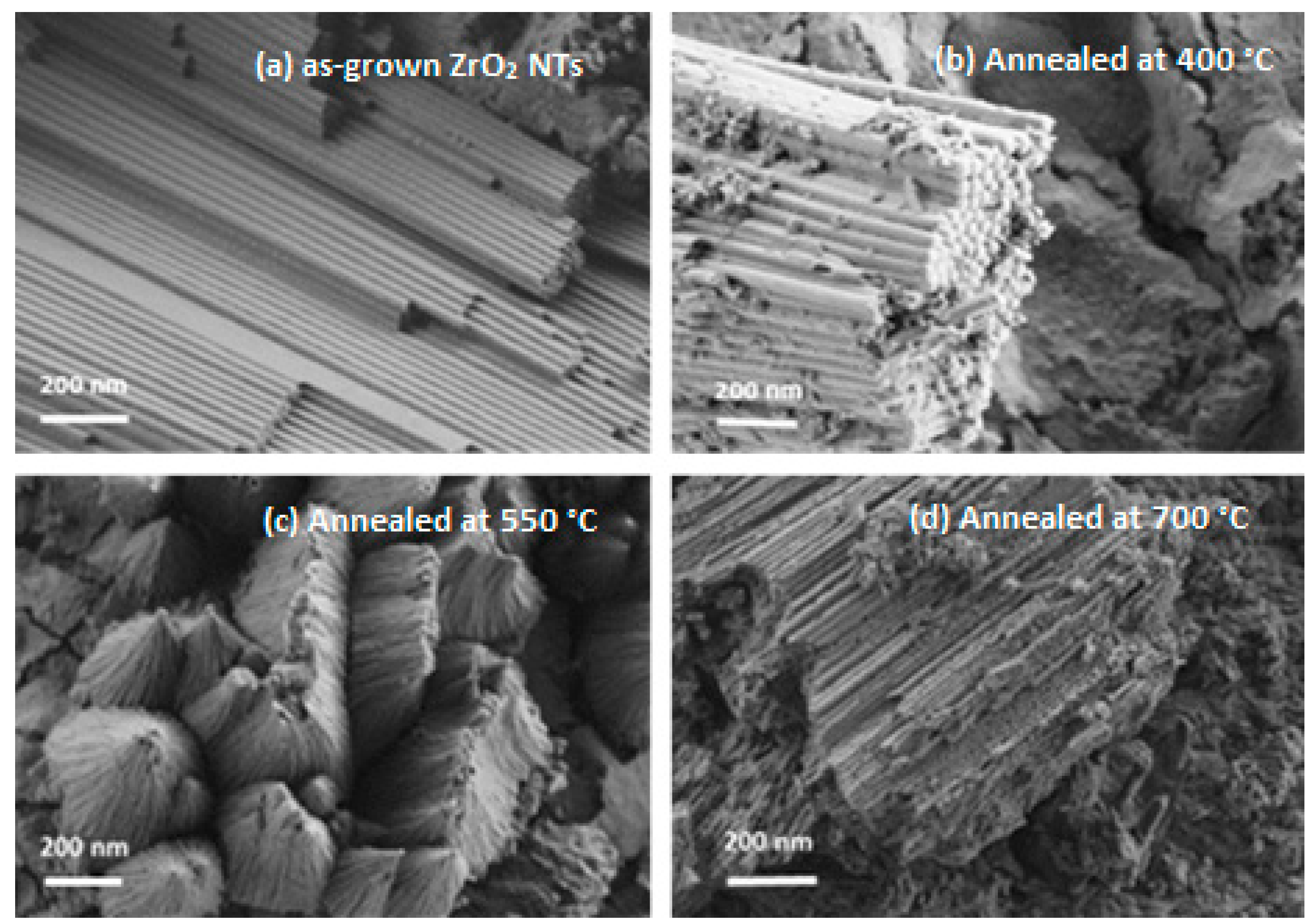

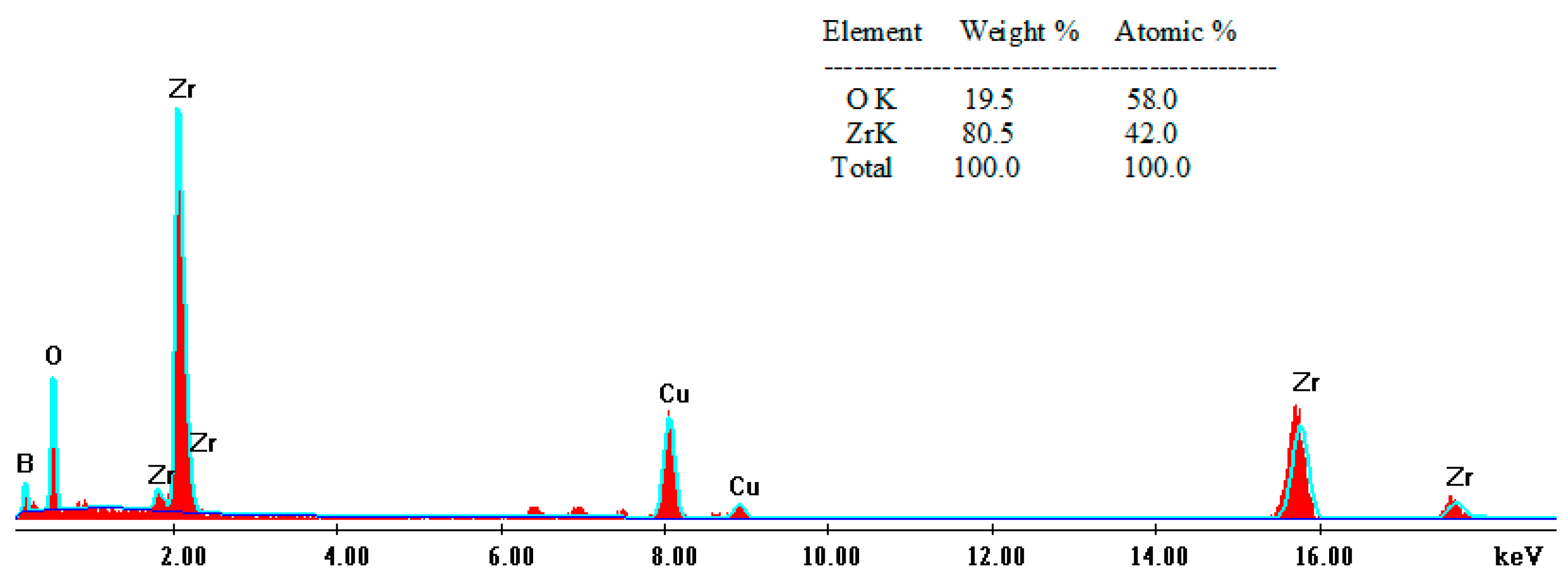
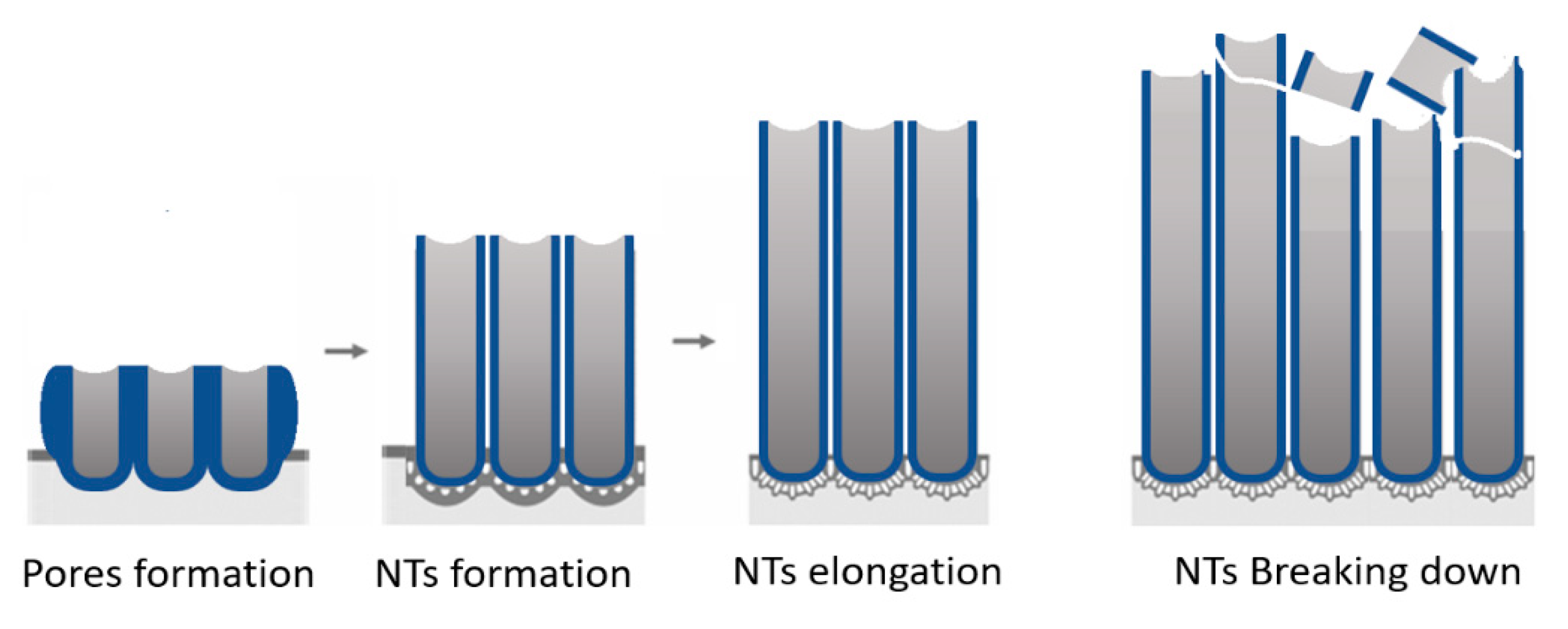
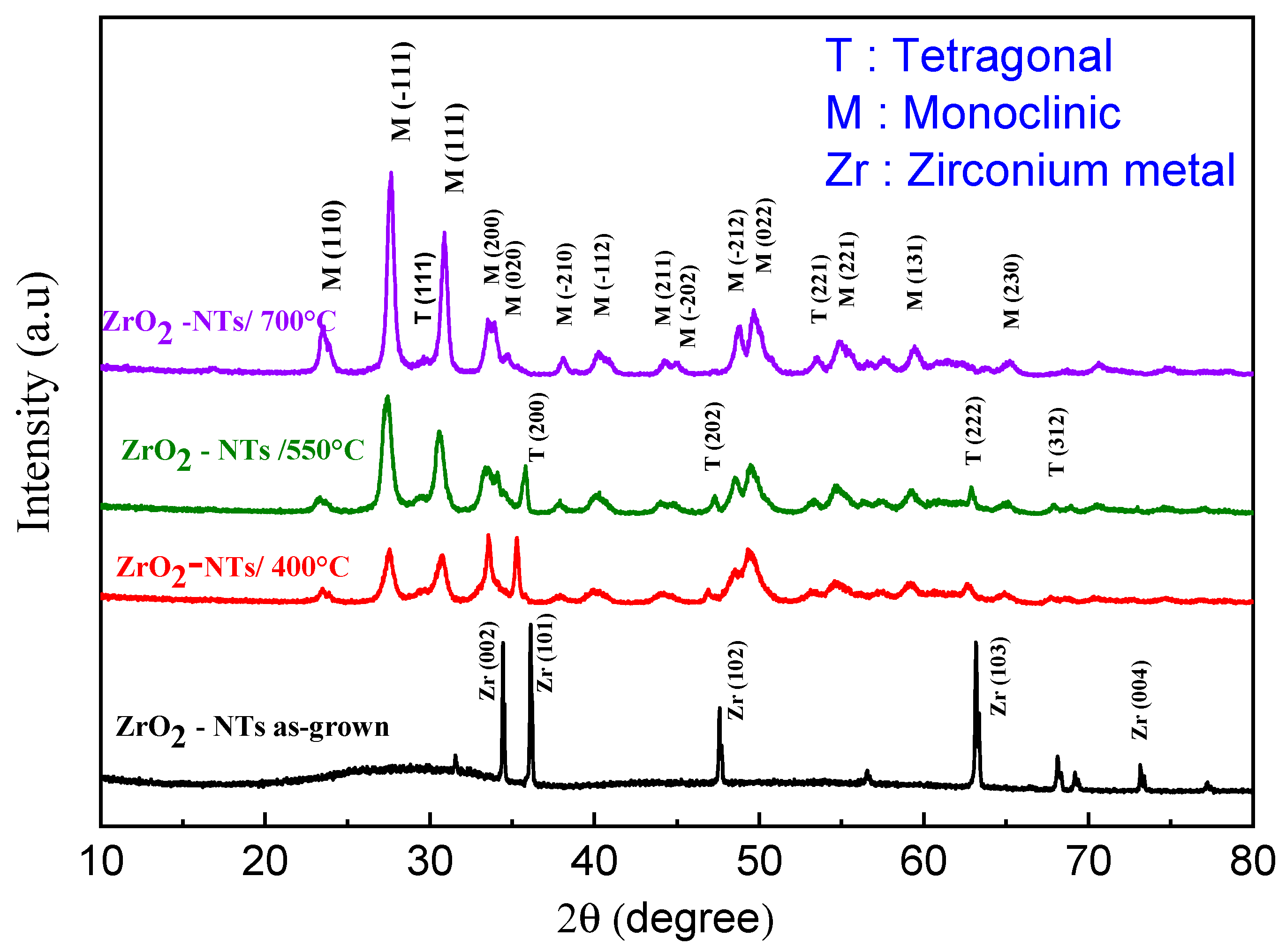
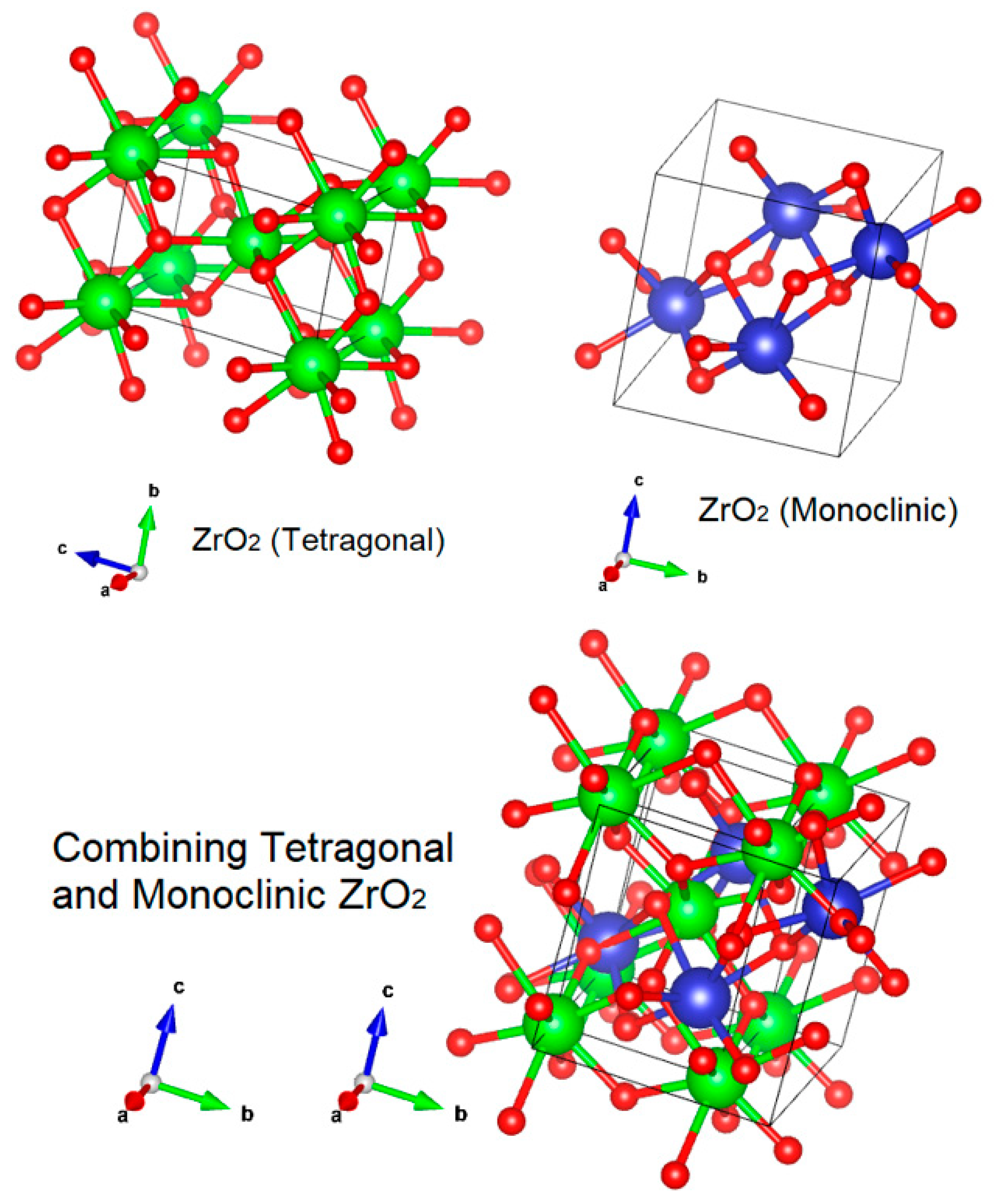

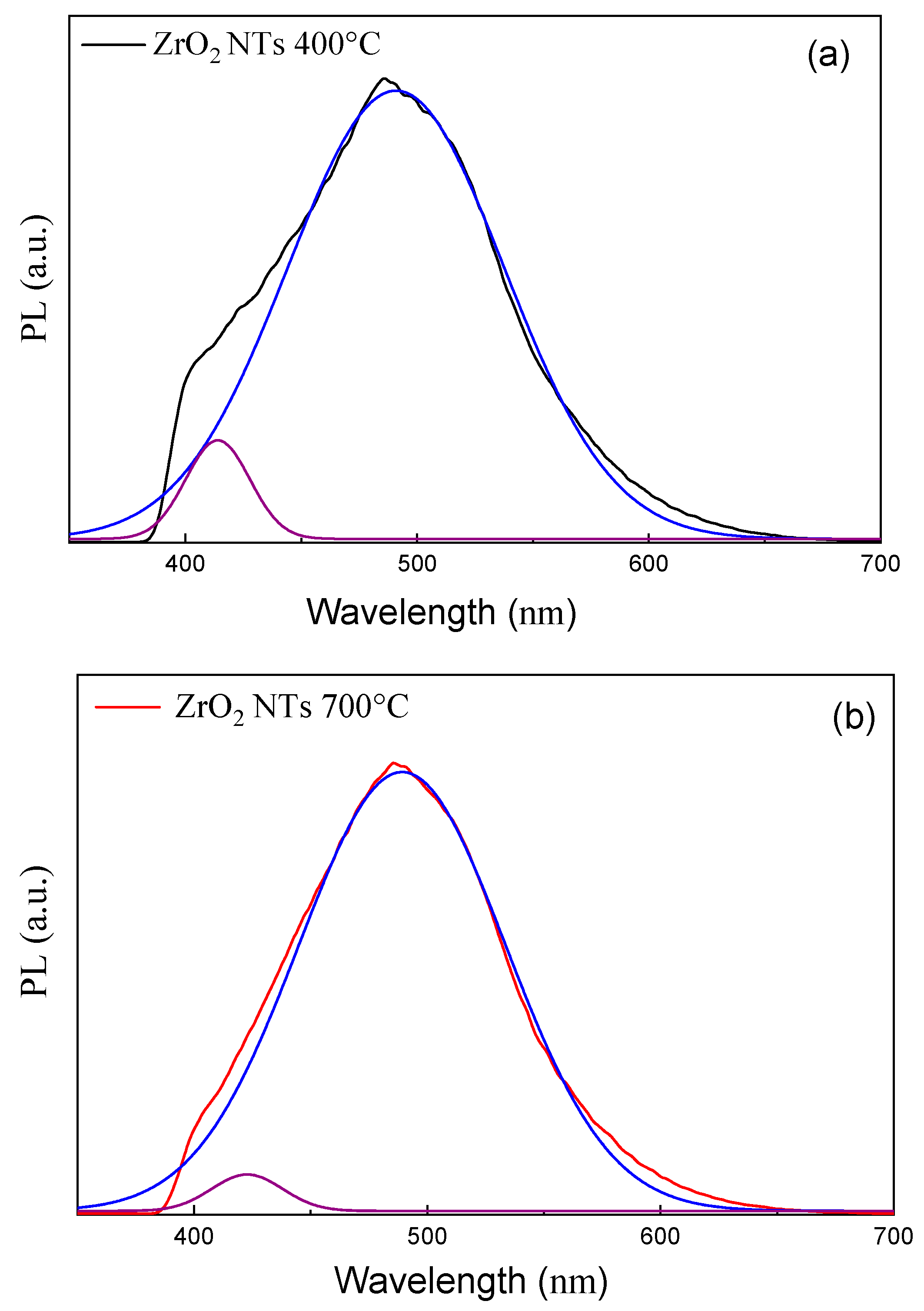
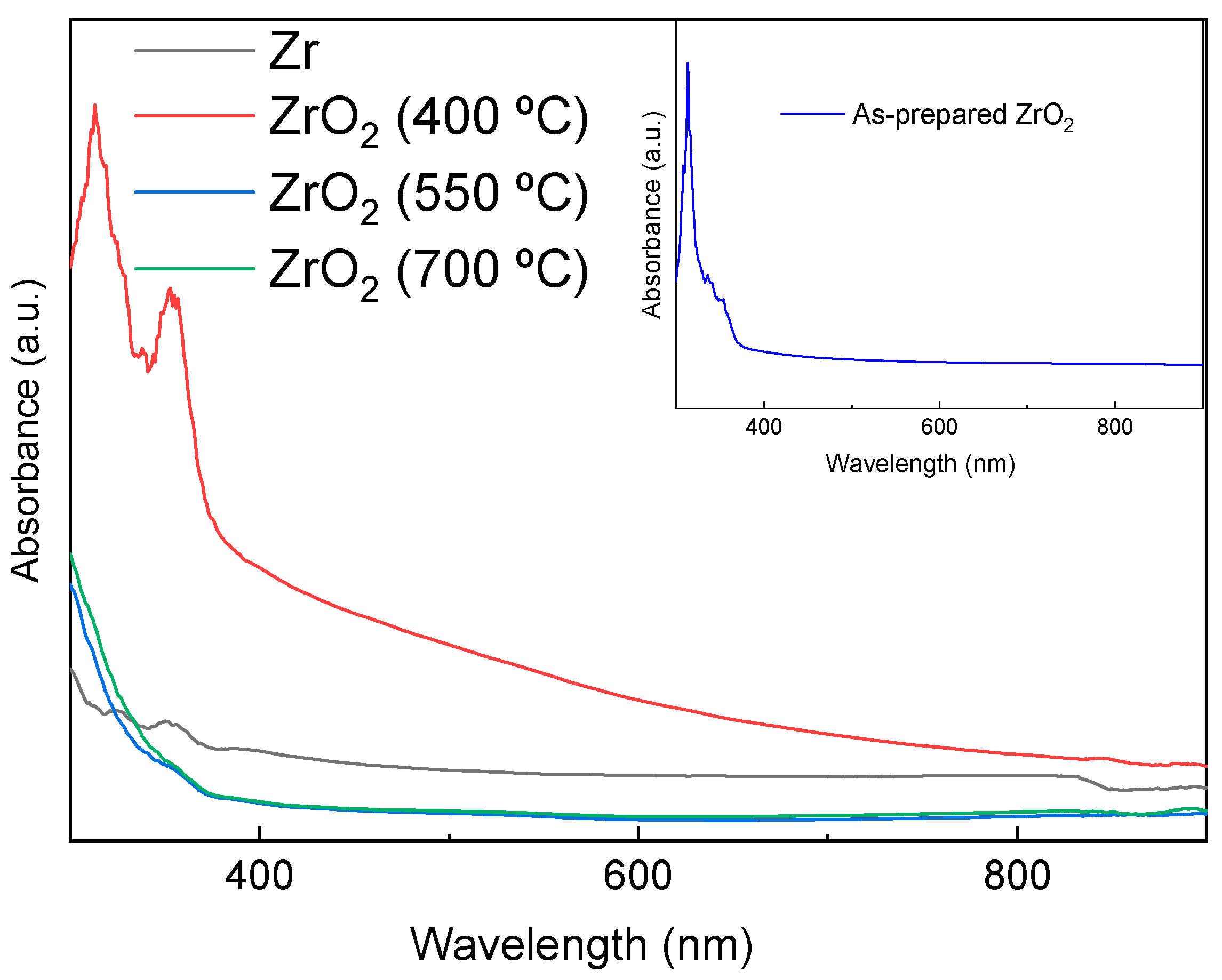
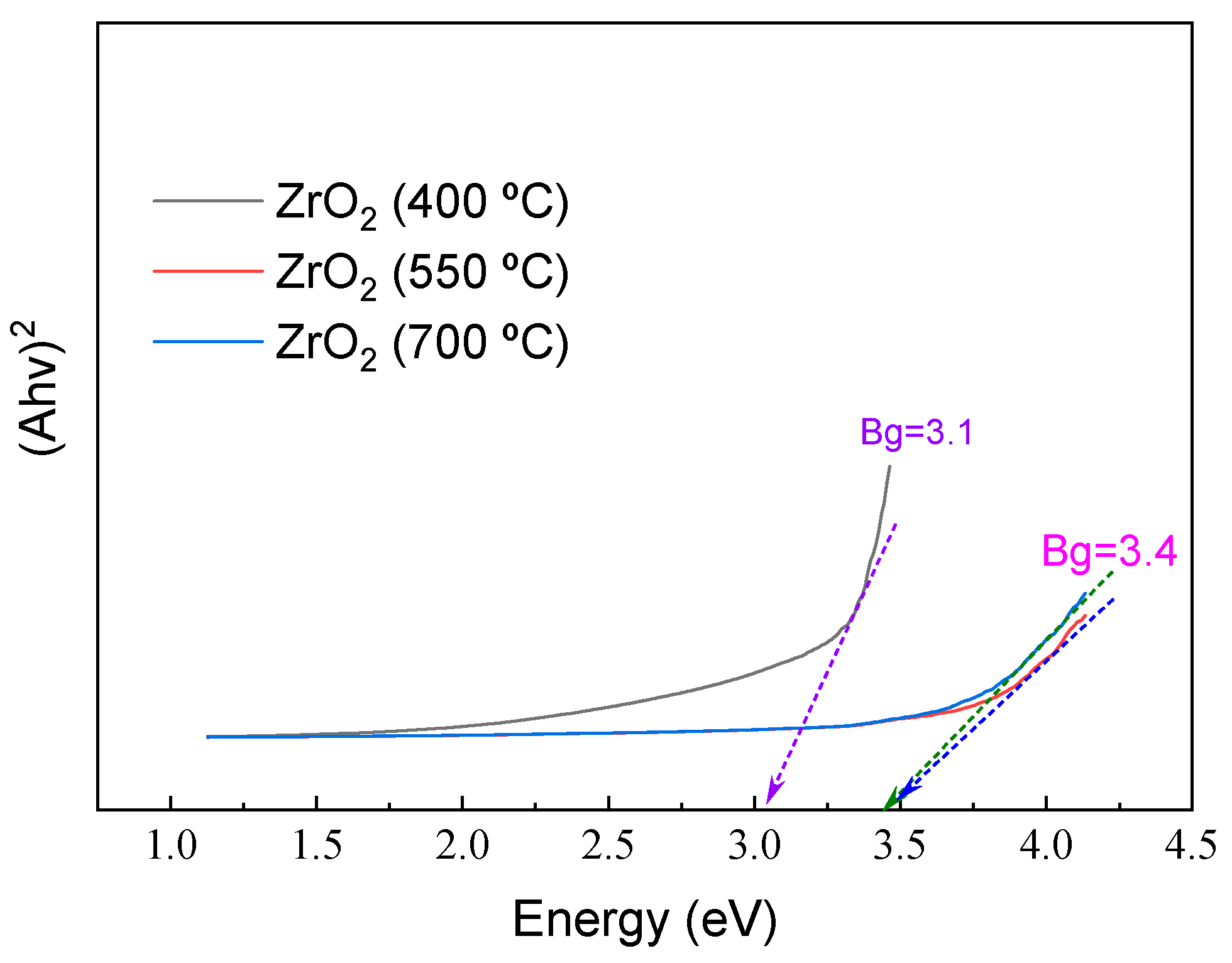
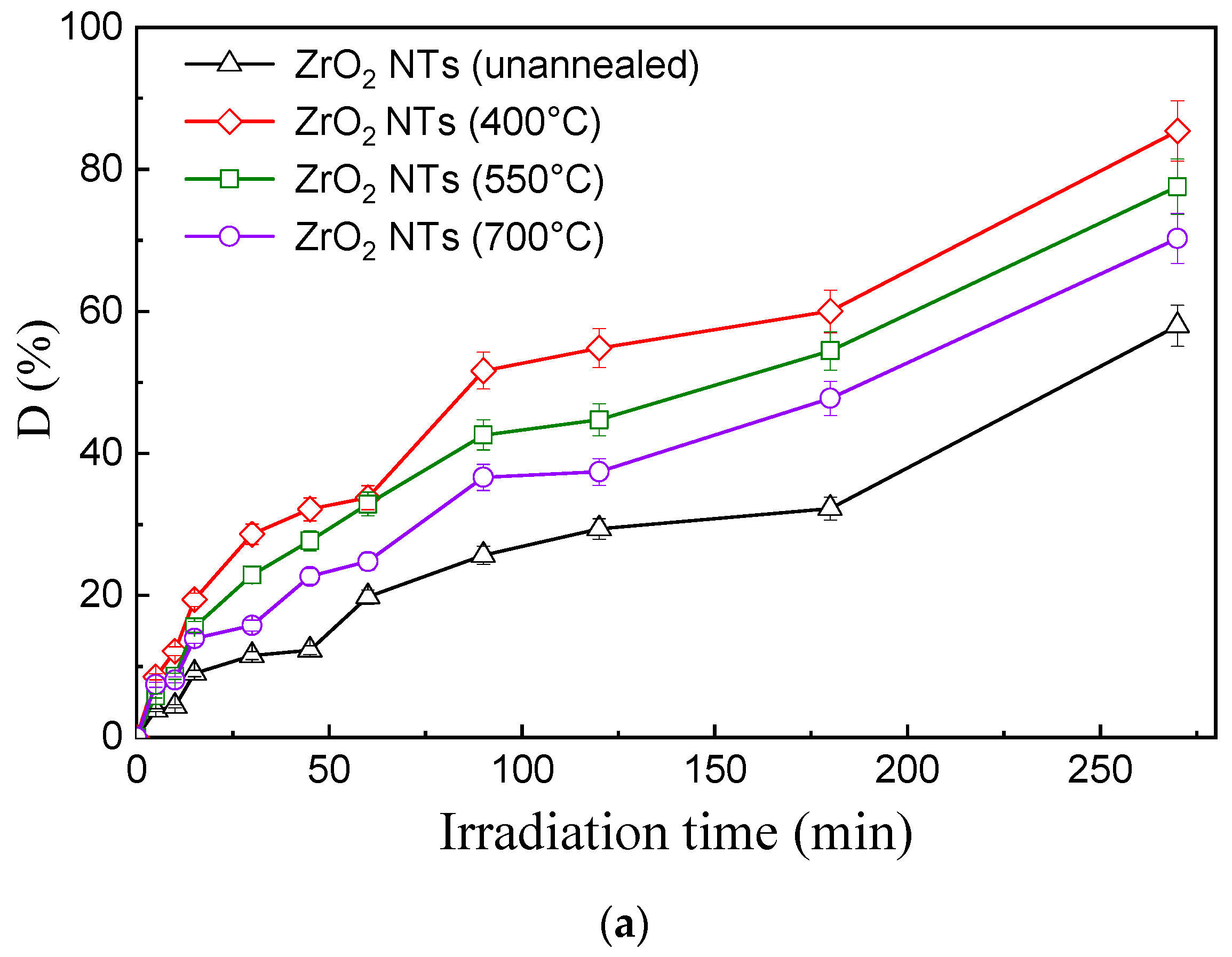
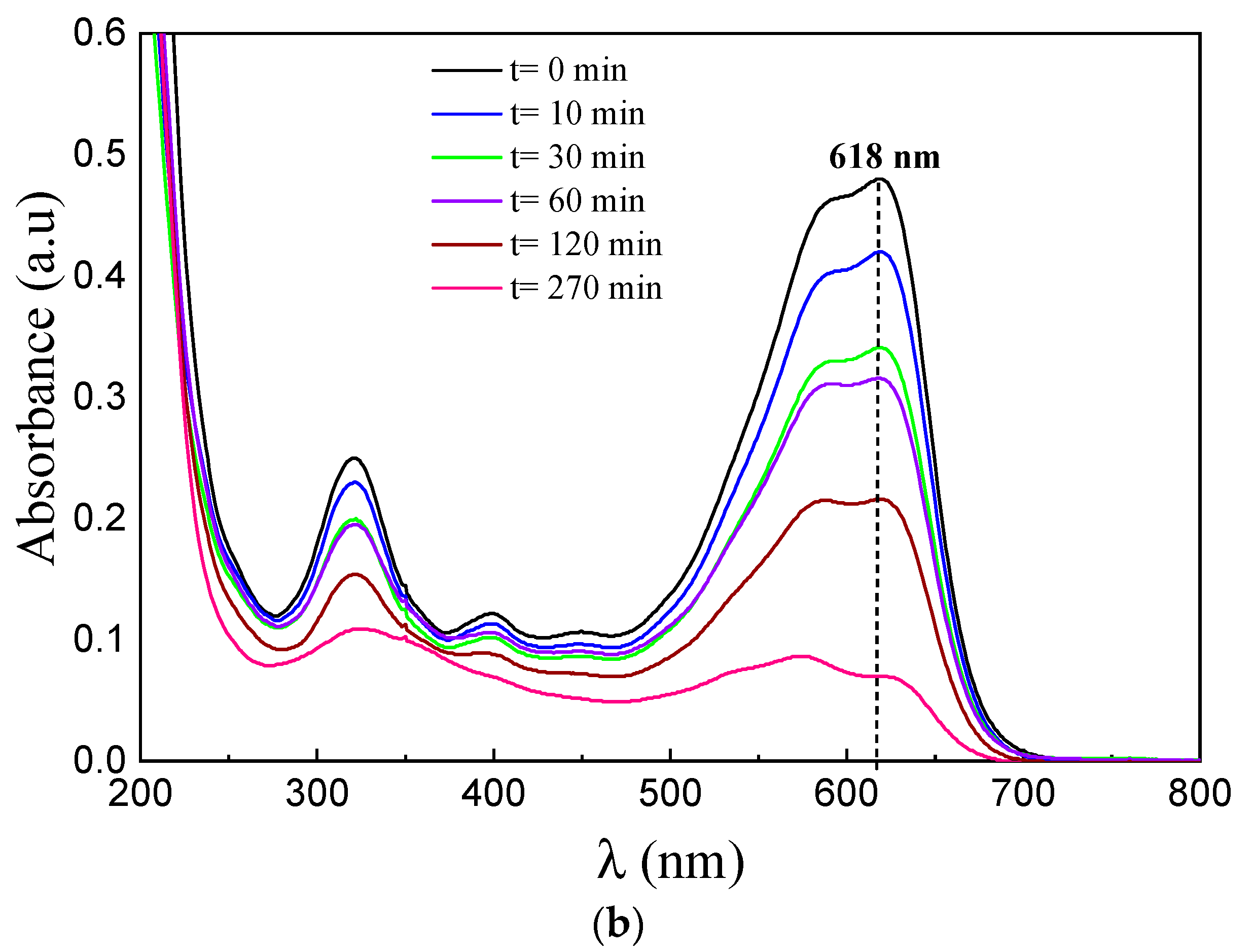
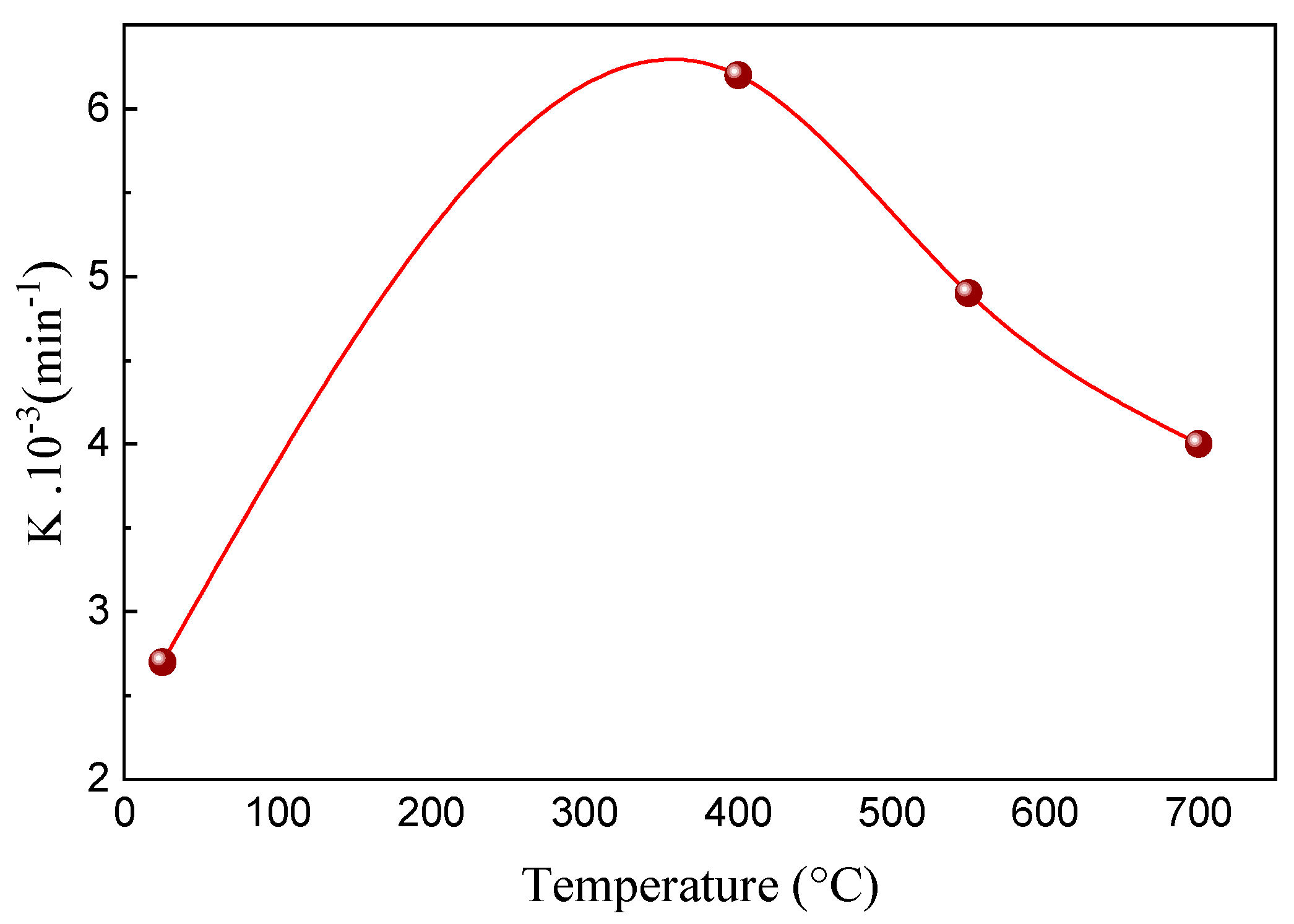
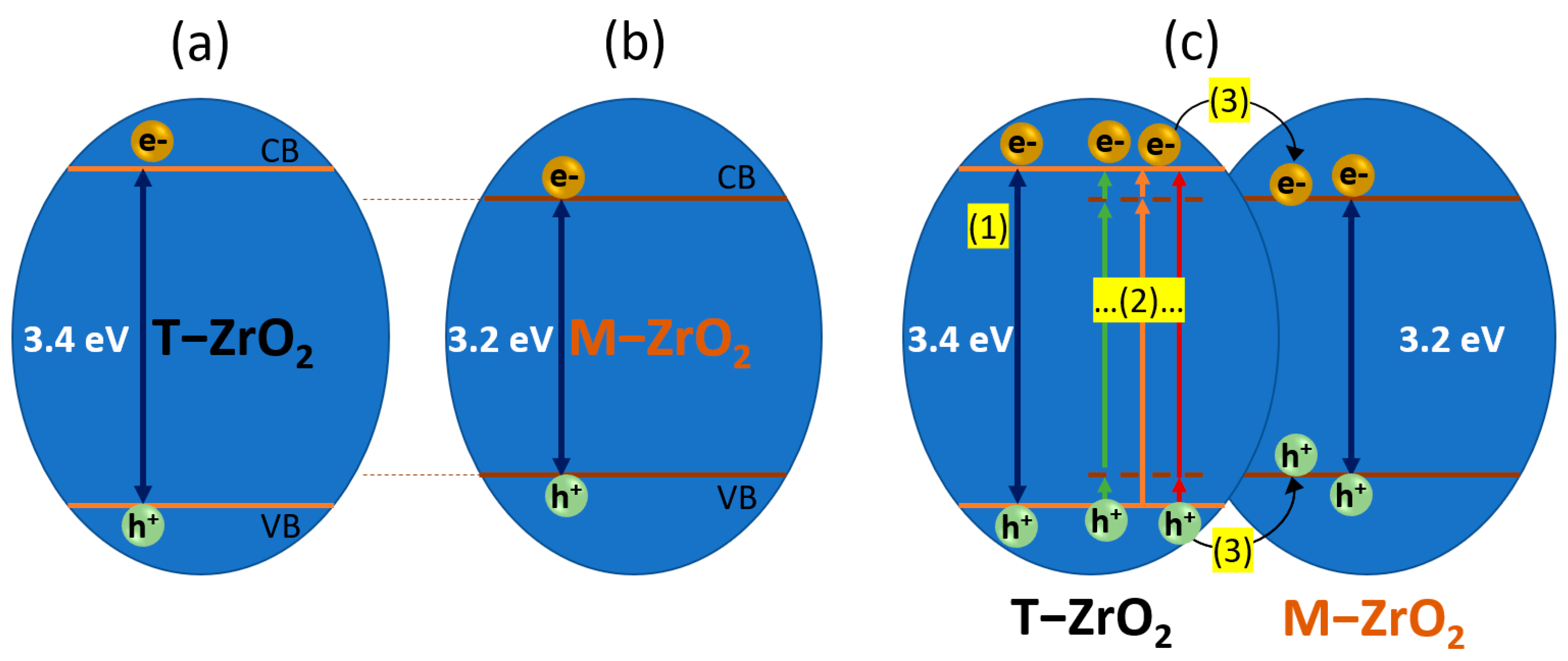

| Annealing Temperature (°C) | 400 | 550 | 700 |
|---|---|---|---|
| D (nm) | 13.1 | 15 | 20.7 |
| θ (rad) | Sin(θ) | (hkl) | Dhkl (Å) | Structure | Lattice Parameter (Å) |
|---|---|---|---|---|---|
| 0.29 | 0.28 | (200) | 2.69 | Monoclinic | a = 5.5 |
| 0.30 | 0.29 | (020) | 2.58 | b = 5.2 | |
| 0.43 | 0.41 | (022) | 1.84 | c = 5.3 | |
| 0.30 | 0.29 | (200) | 2.60 | Tetragonal | a = b = 5.2 |
| 0.54 | 0.51 | (222) | 1.49 | c = 5.1 |
| Sample | Annealing Temperature (°C) | Degradation Rate (%) |
|---|---|---|
| ZrO2-NTs | Unannealed | 57.97 |
| 400 | 85.41 | |
| 550 | 77.57 | |
| 700 | 70.28 |
Disclaimer/Publisher’s Note: The statements, opinions and data contained in all publications are solely those of the individual author(s) and contributor(s) and not of MDPI and/or the editor(s). MDPI and/or the editor(s) disclaim responsibility for any injury to people or property resulting from any ideas, methods, instructions or products referred to in the content. |
© 2023 by the authors. Licensee MDPI, Basel, Switzerland. This article is an open access article distributed under the terms and conditions of the Creative Commons Attribution (CC BY) license (https://creativecommons.org/licenses/by/4.0/).
Share and Cite
Jemai, S.; Khezami, L.; Gueddana, K.; Trabelsi, K.; Hajjaji, A.; Amlouk, M.; Soucase, B.M.; Bessais, B.; Rtimi, S. Impact of Annealing on ZrO2 Nanotubes for Photocatalytic Application. Catalysts 2023, 13, 558. https://doi.org/10.3390/catal13030558
Jemai S, Khezami L, Gueddana K, Trabelsi K, Hajjaji A, Amlouk M, Soucase BM, Bessais B, Rtimi S. Impact of Annealing on ZrO2 Nanotubes for Photocatalytic Application. Catalysts. 2023; 13(3):558. https://doi.org/10.3390/catal13030558
Chicago/Turabian StyleJemai, Safa, Lotfi Khezami, Kaouther Gueddana, Khaled Trabelsi, Anouar Hajjaji, Mosbah Amlouk, Bernabé Mari Soucase, Brahim Bessais, and Sami Rtimi. 2023. "Impact of Annealing on ZrO2 Nanotubes for Photocatalytic Application" Catalysts 13, no. 3: 558. https://doi.org/10.3390/catal13030558
APA StyleJemai, S., Khezami, L., Gueddana, K., Trabelsi, K., Hajjaji, A., Amlouk, M., Soucase, B. M., Bessais, B., & Rtimi, S. (2023). Impact of Annealing on ZrO2 Nanotubes for Photocatalytic Application. Catalysts, 13(3), 558. https://doi.org/10.3390/catal13030558











